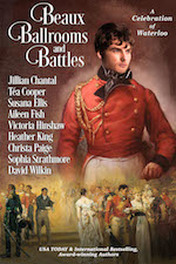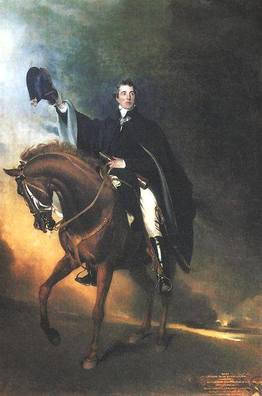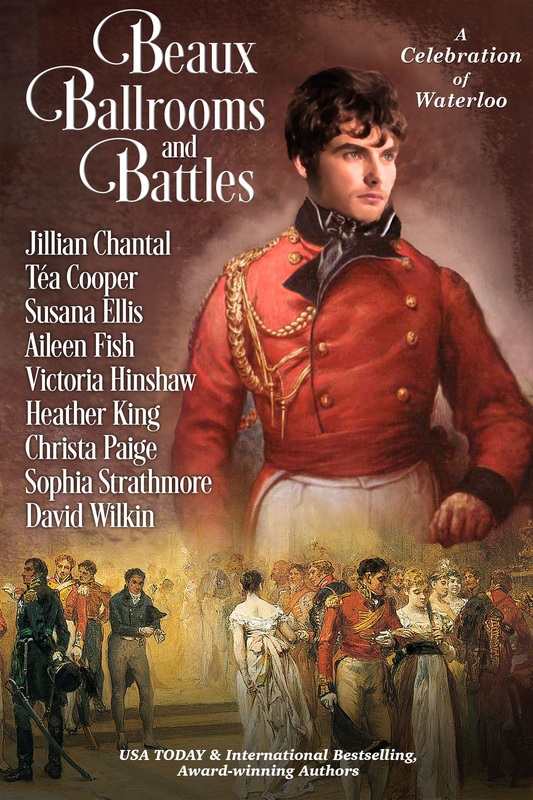
In this portrait of the Duke of Wellington, you get a real sense of the battlefield, with the cannon smoke in the background and the fading sunlight as the general rides away from the scene of his most famous victory, his hat held aloft in salute. Indeed, you can almost smell the smoke and powder residue. Yet the focus is clearly on the Duke and his illustrious horse, Copenhagen.
Described by French artist Delacroix as ‘a flower of politeness’ and by that assertion it can therefore be supposed a gentleman, Lawrence has, with great subtlety, created an imposing image of both an English aristocrat and a commander. The Duke is wearing the same uniform and Copenhagen carries the arms and saddlecloth that they used on 18th June 1815. When the painting was exhibited at the Royal Academy, it was listed as The Duke of Wellington in the dress that he wore and on the horse that he rode, at the battle of Waterloo.
Copenhagen was, of course, the horse Wellington rode for the whole of that momentous day – a stretch of almost eighteen hours. He is frequently termed a charger, for that is a suitable appellation for a battle horse, although the reality is he was not often required to perform that role. A general’s mount has to remain steady and calm under fire and yet be fleet enough of foot to convey his master to all parts of the battlefield in moments. Copenhagen was the ideal general’s mount.
He is depicted by Sir Thomas Lawrence as a rich chestnut, his neck arched in a pose which subtly suggests arrogance and superiority. It has been suggested that he appears to be doing a lateral movement seen in the higher levels of competition dressage – a movement called ‘shoulder in’, where the horse travels at a slight angle, his body turned away from the direction he is moving. I can see where the idea has come from, since such suppling positions, aside from being natural movements seen in horses at play, originally were developed as both defensive and offensive measures when man first saw the potential of mounted combat. The ‘airs above the ground’, such as the courbette, the croupade, the pirouette, the pesade and the capriole demand high levels of athleticism and skill from the horse as well as the rider. Medieval knights spent hours schooling their prized war horses to be quick, responsive and nimble. The shoulder in, for example, which is one of the best suppling exercises, can be used to prevent an enemy foot soldier getting close enough to strike a blow at the rider, or even to barge him to the ground. In this painting, the Duke demonstrates by his balance, depth of seat and easy carriage in the saddle; that he was an accomplished horseman, well capable of such disciplines.
However, that is not my perception, as someone who loves horses and drawing but is no expert.
Copenhagen was the preferred height for a cavalry horse, standing just above fifteen hands (a hand equals four inches, measured to the base of the neck where it joins the body). The Duke was a tall man, which is evident from the length of his legs in the stirrups, and yet Copenhagen is not made to appear pony-like. The pose gives him a powerful presence, the raised forefoot indicating a touch of impatience and even demand. His eye is merely suggested with a speck of white paint, but it is enough, for it cleverly hints at the horse’s supreme confidence and bold character. This, it says, is a horse who knows his own worth; a horse with attitude. He has that indefinable quality which draws the eye. It could be simply the artistry of Lawrence, emphasizing those elegant limbs and clean lines of what is a compact frame, but I prefer to think it is the persona of the horse shining through.
History tells us that Copenhagen inherited his grandsire Eclipse’s difficult temperament and my story "Copenhagen’s Last Charge" is built around an incident that reflected this. It was that very attitude, that lack of respect for the human race – with the exception of Wellington himself – which helped to create that aura of supremacy Lawrence has captured so well. It is that strength of personality and inherent arrogance which made him not only universally popular, but has chiselled his name into the annals of history as one of the greatest war horses ever foaled.
Doubtless his grooms called him by some stable name, but I suspect it would not have been too complimentary! Did the Duke do so too? As a man whose public image was austere and stern, it is hard to imagine, but perhaps, out of the public eye, in the Ice House Paddock at Stratfield Saye, the Duke’s Hampshire estate, Copenhagen and his master enjoyed a few moments when they both laid aside their egos and admitted how much each owed the other.
Here is Susana's description of the anthology: “June 18, 1815 was the day Napoleon Bonaparte's Grande Armée was definitively routed by the ragtag band of soldiers from the Duke of Wellington's Allied Army in a little Belgian town called Waterloo. The cost in men's lives was high—22,000 dead or wounded for the Allied Army and 24,000 for the French. But the war with Napoleon that had dragged on for a dozen years was over for good, and the British people once more felt secure on their island shores.”
Here is a synopsis of "Copenhagen’s Last Charge:"
When Meg Lacy encounters a broodingly handsome Light Dragoon at the Duchess of Richmond’s grand ball, she little expects that in the hours following the Battle of Waterloo she will be accompanying him around the streets of Brussels. Romance is the last thing on her mind as they seek a lost and valuable item belonging to the Duke of Wellington himself.
Lieutenant James Cooper is surly and unhelpful, but Meg senses the Dragoon will need her help if they are to succeed. As they bicker their way around the narrow streets, a strange empathy begins to develop as gradually glimpses of the man beneath start to be revealed. Meg finds herself drawn to that person, but when they finally recover and then return the item to the Duke, Cooper makes a grave error of judgement which jeopardizes their budding friendship…
Here is an excerpt from the story:
Standing beside her father as he discussed cavalry tactics with General Lord Edward Somerset, Meg had the opportunity to observe the milling crowd ‒ the flushed cheeks of the young ladies as they danced by with equally youthful, dashing officers; the happy smiles and carefree pursuit of pleasure, all as though the French were not gathering to Bonaparte’s banner with the intention of destroying them all. Although the beau monde of Brussels was partying as if the escaped Emperor were but a fly to be swatted, Meg took a more realistic view. During the crossing to the Continent, she had become acquainted with a young man, Godfrey Winterton, who was seeking his elder brother. Their father was ill, not expected to live beyond a few weeks and the boy – for he could barely own more than seventeen years – was desperate to find his sibling, the heir to the family estates, before the unthinkable occurred. Unthinkable it might be, but to Meg it was not something to be ignored, swept beneath a rug until someone fell over the ensuing lump.
She was glad when the music stopped and Georgy came to claim her attention from her maudlin thoughts. In her tempestuous wake, Georgy dragged her brother, the Earl of March. He was a handsome young man of four-and-twenty, a few years senior to both Meg and his sister. He was already Aide-de-Camp to the Prince of Orange and bidding fair to enjoy an illustrious military career.
He bowed deeply as Georgy presented them and begged the honour of the next dance. A quadrille was forming and feeling her cheeks heat at the honour he did her, when there were several beauties of higher rank present whom could be said to have greater claim, Meg curtsied.
“I should be pleased, my lord.” The words had barely formed on her lips when Georgy nudged her arm.
“Who do you suppose that could be?”
Meg followed the line of her friend’s gaze to observe a tall, leanly built officer in the blue coat and white facings of a cavalry regiment, who was leaning casually against a pillar near the French windows, which had been opened to admit the warm night air. In his hand he held his red silk embellished dress helmet, as though he had little intention of remaining.
“I cannot conjecture,” she replied with a smile. “Recollect I have but recently arrived and know hardly anyone.”
“Oh, tush!” Georgy tapped the precious fan on Meg’s arm. “He is very fine, do you not agree?” She chuckled. “And with a mien almost as brooding as Lord Byron!” Turning abruptly to her brother, she said, “March, do be a dear and go discover who he is!”
About the Author
Heather King has made up stories since she was a small child. History lessons at school were rarely dull and the discovery of Georgette Heyer’s Regency novels in her early teens set her on a lifelong love of that era. A confessed romantic and bookworm, writing gives her a chance to indulge all these passions – and call it work!
She has her own voice, but likes to follow traditional Regency precepts and pen uplifting stories with witty dialogue, engaging characters and bags of emotion. Her debut novel was 'A Sense of the Ridiculous'.
Visiting her Dark Side as Vandalia Black, she writes Vampire and Paranormal romance. She is the author of 'Vampires Don’t Drink Coffee and Other Stories' which includes a novella set in the English Civil War.
When not looking after her two hairy ponies, three cats and boisterous Staffie X, or frowning over keypad or notebook, she likes nothing better than to curl up with a good book.
Join Heather on Social Media:
Blog: http://regency-writer-hking.blogspot.co.uk
Facebook: https://www.facebook.com/heather.king.author
https://www.facebook.com/ARegencyRepository
Goodreads: https://www.goodreads.com/goodreadscomheatherkinguk
Amazon Author Page: http://www.amazon.co.uk/-/e/B00I04PYPE
Heather's Other Books
A Sense of the Ridiculous – not currently available, but will be before long.
Waking up at a strange inn with no memory, headstrong Jocasta Stanyon finds the landlady’s son, Richard Cowley, is more than a match for her lively personality, but their stations in life are far apart and despite prolonging her stay by devious means, the idyll cannot last. She hopes to persuade her father of Richard’s qualities, but then she is summoned to receive the addresses of a fashionable stranger...
An Improper Marriage
Marriage to dull ironmaster Jeremiah Knight would be awful enough, but when Eleanor Honeybourne discovers an injured man at a ball, she uncovers a web of intrigue that puts her own and her stepfather’s lives at risk. Meeting again her childhood hero, Charles Ribblesford, she is forced into a situation which could well spell her ruin, unless they can solve the mystery and unmask the villain.
http://www.amazon.co.uk/Improper-Marriage-Heather-King-ebook/dp/B00TP1ZE4C/ref=asap_bc?ie=UTF8
http://www.amazon.com/Improper-Marriage-Heather-King-ebook/dp/B00TP1ZE4C/ref=asap_bc?ie=UTF8
The Middle Of The Day
Lottie Morgan loves all things Regency, but would she like to live in the early nineteenth century, married to a baron? A strange thing happens while she is visiting Berrington Hall; she finds herself confronting George, Lord Rodney and she is a newly-wed!
http://www.amazon.com/dp/B00UUQ7GE2
http://www.amazon.co.uk/Middle-Day-Heather-King-ebook/dp/B00UUQ7GE2/ref=la_B00I04PYPE_1_3?s=books&ie=UTF8&qid=1427237184&sr=1-3
Writing as Vandalia Black:
Vampires Don’t Drink Coffee And Other Stories
This collection of fourteen tales brings together irresistible heroes and memorable heroines who battle against demons, muggers, lost loves, loneliness and unholy thirst to find their true loves. Tortured and honourable vampire heroes and one lady for whom the search for her mortal love has lasted centuries, will sweep you away into a paranormal world where eternal love means exactly that.
http://www.amazon.co.uk/Vampires-Drink-Coffee-Other-Stories/dp/1500219096/ref=sr_1_13?s=books&ie=UTF8&qid=1406294881&sr=1-13&keywords=vampires+romance+short+stories+anthology
http://www.amazon.co.uk/Vampires-Drink-Coffee-Other-Stories-ebook/dp/B00N05GXZI/ref=tmm_kin_swatch_0?_encoding=UTF8&sr=1-13&qid=1406294881
http://www.amazon.com/Vampires-Drink-Coffee-Other-Stories/dp/1500219096/ref=sr_1_cc_1?s=aps&ie=UTF8&qid=1406297421&sr=1-1-catcorr&keywords=vandalia+black+vampires+short+stories+anthology
http://www.amazon.com/Vampires-Drink-Coffee-Other-Stories-ebook/dp/B00N05GXZI/ref=tmm_kin_swatch_0?_encoding=UTF8&sr=1-1-catcorr&qid=1406297421
MORE DETAILS ABOUT THE ANTHOLOGY;
http://beauxballroomsandbattles.com/
Facebook Page:
https://www.facebook.com/groups/BeauxBallroomsandBattles/
Rafflecopter (ends April 18th)
Links
Amazon.com: http://www.amazon.com/Beaux-Ballrooms-Battles-Celebration-Waterloo-ebook/dp/B00V4TAP38
Kobo: https://store.kobobooks.com/en-US/ebook/beaux-ballrooms-and-battles
iBooks: https://itunes.apple.com/us/book/beaux-ballrooms-and-battles/id980212875?ls=1&mt=11
Nook: http://www.barnesandnoble.com/w/beaux-ballrooms-and-battles-aileen-fish/1121661295?ean=2940151319669
Amazon.uk: http://www.amazon.co.uk/Beaux-Ballrooms-Battles-Celebration-Waterloo-ebook/dp/B00V4TAP38
Amazon.ca: http://www.amazon.ca/Beaux-Ballrooms-Battles-Celebration-Waterloo-ebook/dp/B00V4TAP38
Amazon.au: http://www.amazon.com.au/Beaux-Ballrooms-Battles-Celebration-Waterloo-ebook/dp/B00V4TAP38
Victoria, here. Many thanks, Heather for your insights on Copenhagen. Below, to end this post, is a picture of the stallion's grave at Stratfield Saye, Country Seat of the Dukes of Wellington, with the roses we brought for him:





 RSS Feed
RSS Feed